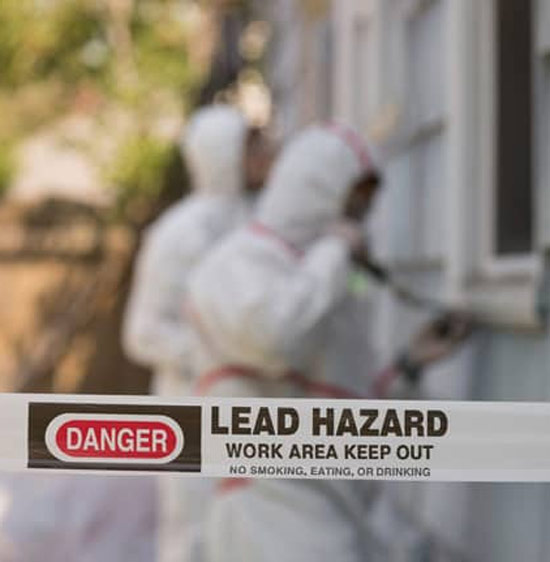Expert Lead Violation Removal in NYC-- Safeguard Against Health Hazards
Expert Lead Violation Removal in NYC-- Safeguard Against Health Hazards
Blog Article
Step-by-Step Refine for Successful Lead Violation Removal
Following this, adherence to federal and state regulations is extremely important to formulating a reliable removal strategy. The actual removal requires competent personnel to implement these strategies while purely complying with security procedures. What takes place after the removal is completed?

Detection and Assessment
Detection and assessment are essential steps in the remediation of lead infractions. To guarantee an effective remediation process, it is vital to perform a complete examination of the environment where possible lead exposure exists.
As soon as detection is achieved, a thorough assessment needs to be undertaken. This consists of assessing the level and seriousness of contamination, along with recognizing populaces in jeopardy, particularly kids and expectant ladies. Threat analyses frequently include tasting and laboratory analysis, environmental surveys, and wellness effect research studies. The gathered information ought to be meticulously documented to sustain the advancement of an effective remediation strategy (Lead Violation Removal in NYC).
In addition, it is vital to focus on locations with the greatest levels of contamination and those that present the biggest health risks. Reliable interaction with stakeholders, including homeowner, locals, and public health and wellness authorities, is critical for guaranteeing that all events are notified regarding the findings and the subsequent actions required for remediation. This first discovery and assessment phase lays the foundation for a successful lead infraction removal procedure.

Legal and Regulative Conformity
Browsing the landscape of legal and regulatory conformity is a critical element of effective lead infraction removal. Compliance makes sure not just the safety and security of affected populations yet likewise the reputation and legal standing of the organization accountable for removal.
This includes precise documents of all remediation activities to show conformity. Failing to adhere to these policies can result in severe charges, consisting of large fines, lawful activity, and reputational damages.
Involving lawful experts specialized in ecological law can facilitate browsing these complexities. Routine training and accreditation for all personnel included in the removal procedure are likewise necessary to ensure adherence to safety and security and regulatory standards. By prioritizing legal and regulative conformity, companies can efficiently minimize risks and attain a successful remediation end result.
Preparation the Removal
Effectively intending the removal of lead violations starts with an extensive evaluation of the infected site. This first assessment needs to include an in-depth site examination to identify the level and concentration of lead contamination. Comprehensive sampling and lab analysis are critical to develop a precise contamination account. This data-driven approach guarantees that remediation efforts are appropriately targeted and efficient.
When the contamination is mapped, a risk evaluation should be conducted to assess possible health threats to people and the environment. Lead Violation Removal in NYC. This evaluation should consider aspects such as direct exposure paths, populace susceptability, and ecological effects. The understandings collected will create the basis for picking a proper remediation strategy
Ultimately, setting clear, attainable objectives for the remediation job is essential. These purposes should align with governing requirements and stakeholder Lead Removal Contractors assumptions to make certain compliance and area approval. Developing an in-depth remediation strategy that details methods, timelines, and source allocation will help with a structured technique to the cleanup process.
Additionally, it is necessary to engage with stakeholders early and maintain transparent communication throughout the planning phase. This includes informing local neighborhoods, acquiring needed authorizations, and collaborating with regulatory agencies to make sure all lawful and procedural requirements are satisfied. A well-crafted remediation plan not just deals with the contamination efficiently yet also develops trust fund and cooperation among all parties included.
Implementing the Removal
With a well-structured remediation strategy in position, the emphasis shifts to the real execution of the remediation tasks. This phase includes setting in motion the necessary sources, including competent employees, specialized equipment, and premium products. Begin by plainly defining roles and duties to ensure liability and seamless sychronisation among employee.
This includes establishing up control areas to avoid lead dirt and debris from dispersing, as well as using air filtering systems to preserve air quality. Utilize methods such as wet scraping, chemical removing, or encapsulation, depending on the seriousness and location of the contamination.
Throughout the removal process, conduct regular evaluations and air quality keeping track of to make certain compliance with governing requirements. Reliable communication with stakeholders, including homeowner and occupants, is critical to maintain them educated of progress and any kind of unforeseen advancements. By meticulously adhering to these actions, the removal tasks can be performed successfully and effectively, eventually mitigating lead hazards.
Post-Remediation Techniques
Post-remediation strategies play a critical duty in ensuring the lasting success of lead infraction remediation initiatives. These strategies include recurring tracking, maintenance, and area education and learning to stop future lead direct exposure my review here and make certain a secure atmosphere.
First, regular surveillance is essential. This includes routine screening of the formerly influenced locations to make certain that lead levels continue to be within secure limitations. Residential or commercial property proprietors must develop a routine for these examinations, preferably in collaboration with certified ecological experts.

Third, enlightening the area plays a crucial duty in sustaining the click to investigate benefits of removal. Citizens and residential or commercial property supervisors must be informed concerning the threats of lead exposure and the very best practices for keeping a lead-safe atmosphere. Workshops, informational pamphlets, and community conferences can be reliable devices for disseminating this details.
Conclusion
Successful lead offense remediation calls for a detailed, methodical strategy encompassing discovery and analysis of contamination, adherence to lawful and regulatory standards, meticulous preparation, and efficient implementation of removal efforts. Post-remediation strategies, consisting of constant surveillance and neighborhood education, are necessary to sustain a lead-safe environment. Collaboration with environmental experts makes certain continuous compliance and security of public health. This systematic process highlights the importance of thoroughness and alertness in resolving and mitigating lead contamination.
Report this page